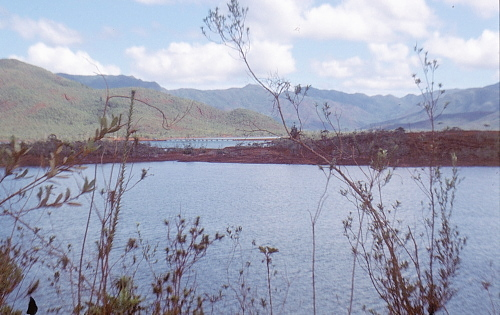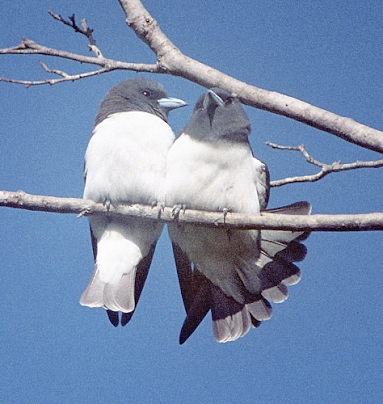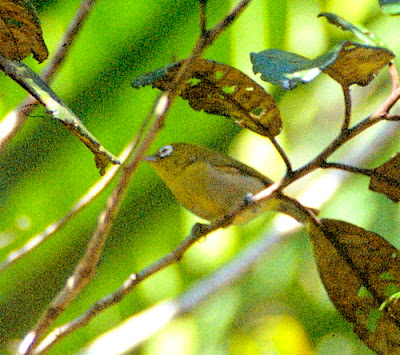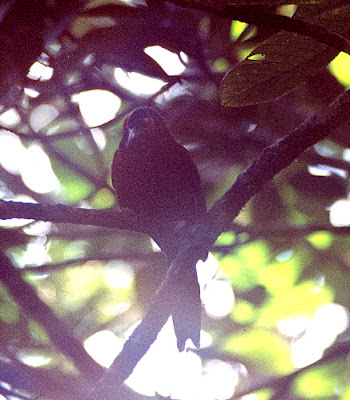New Caledonia 1998
I travelled to New Caledonia with Richard Fairbank and Garry Edwards from Melbourne on a Quantas flight returning to Sydney and the return flight cost less than £200. We hired a car through Avis at Noumea airport and as we had already found out that food was expensive here we decided to take most of our supplies with us apart for bread and fruit. We also had tents with us, which we were using in Australia,and we had no problems camping anywhere including close to the Airport on the final evening. We changed currency in the Airport terminal and the unit of currency is the French Pacific Franc (CPF).The weather was good, generally warm and sunny during the day with some light rain at nights. Although it became hot around mid-day it was not humid and we found we could bird-watch throughout the day. The day we spent at Mount Koaghis, it was very windy and this made birding difficult but the rest of the time it was calm. We had no problems from insects.
The language is French although we did meet some locals who spoke English. Visas not required for EEC passport holders. Driving is on the right hand side and although petrol was more expensive than in Australia, we found it still to be cheaper than in the UK, and anyway you do not have to do much in the way of mileage. During our five days we probably only covered 250 miles.There are over 20 endemic or near-endemics present on the Island including the endangered Kagu and therefore if you are planning a trip to Australia, a short side-trip of around five days to New Caledonia is well worth while, as you could expect to see twenty plus species which you would not see in Australia. I saw twenty-three new species in five days.
There is a local ornithologist Yves Letocart who has a house in the Riviere Bleau National Park. We made arrangements to contact him on our third day and by this time we had seen most of the endemics and therefore we could concentrate on the few species we still needed when we were with him. He had good tapes of the more difficult species. We contacted him by asking at the entrance gate and they told us where his property was and where we could find him.
Under the species list I have included some identification notes on the endemics as there are no easily obtainable field guides. In this respect, I have taken information from a trip report by Richard Thomas who visited the Island in 1992 and provided much useful information on the identification. I have used this information in this report and have supplemented it with my own observations. I would like to thank Richard for these extremely useful notes and we did not have any problems with identification.
ITINERARY
16th Aug Riviere Bleue National Park, the Park closes at 5pm and does not open Mondays,so we had to leave the Park and we camped overnight near the Hotel at Mount Koaghis.
Riviere Bleue National Park Entrance sign, New Caledonia.
17th Aug All day Mount Koaghis birding along the summit track returning in the evening to Riviere Bleue National Park where we camped outside the entrance gate.
View taken from Mt. Koaghis.
18th Aug All Day Riviere Bleue National Park camping overnight in the attractive small
campsite situated about 15 miles from the entrance gate.


Views taken inside the Riviere Blueu National Park, New Caledonia.
The Great Tree in the National Park.
19th Aug All Day Riviere Bleue National Park using the same camp-site.
Early morning mist taken from our camp-site inside the Riviere Bleue National Park.
20th Aug Morning : Riviere Bleue National Park, afternoon we drove to Yate and the along
East coast to Goro, camping overnight close to the Noumea Airport for our return flight
in the early morning to Sydney.
Two general views taken on New Caledonia.
LITTLE PIED CORMORANT Phalacrocorax melanoleucus
Three singles seen on the 16th, 19th and 20th. All flying along the flooded river in the Nat.Park.
WHITE FACED HERON Ardea novaehollandiae nana
Just a single bird seen in the Nat.Park on the 19th.
EASTERN REEF HERON Ardea sacra albolineata
One seen flying along the coast near Yate on the 20th. Endemic subspecies.
WHISTLING KITE Heliasur sphenurus
Four seen on the 16th and 19th in the Nat.Park and one on the 20th near the coast.
SWAMP HARRIER Circus approximans
A single bird seen in the Nat.Park on the 19th.
WHITE-BELLIED SPARROWHAWK (BLUE GOSHAWK) Accipiter haplochrous
Two adults seen in a small wood along the coast near Yate on the 20th.
A striking species, appeared noticeably smaller and more compact than our own Sparrowhawk. The adults are slaty-blue on the upper parts with the breast slaty with a bluish cast, remainder of underparts
striking white. Legs and cere yellow. Fast direct flight. Immatures are brown with streaked underparts and could be confused with Brown Goshawk.
OSPREY Pandion haliaetus
Two seen along the coast near Goro on the 20th.
KAGU Rhynochetus jubatus
Four of these bizarre birds were seen in the Nat.Park on the 18th with at least 7 and possibly 10 seen on the 19th with two on the 20th. Chiefly seen in the forest or along the road running through the forest but also two seen on two days coming out of the forest and feeding on the grass at the camp-site.
Considered by Collar as endangered. Yves Letocart informed us that predation is chiefly by dogs and cats. The population has increased from 80 birds in the Nat.Park in 1980 to about 300 birds now this is due to the fact that all dogs and cats have virtually been eliminated from the Park and the population is still increasing. There are probably another 500 birds in the North of the Island although there are no plans to make any more National Parks.
Kagu is a Night Heron size bird, virtually flightless and we watched them feeding on worms. They are pale grey with a pale brownish wash on the upper parts and some have a pale brownish smudge on the breast. Large pale crest and darkish bars on the wings. Bill is long orangie-red and legs are reddish. At dawn,they make a loud dog like yap repeated and they call for around twenty minutes. When you are close to them, they seem to get annoyed and will make a loud hiss at you. When you approach them, they seem to run and then suddenly stop and then run on again. On several occasions while we were watching them, two would almost bump into one another while they were running around and they would become very excited by raising their crests and sometimes spreading their wings before running on. On one occasion, we observed one calling from a log throwing its head backwards and forwards and half raising its crest. It was joined by a second bird which jumped up onto the log a foot from the first bird and also started to call. They both kept up this behaviour for five minutes. Without doubt the highlight of the trip to New Caledonia and a truly bizarre bird and one of the strangest I have seen.






Various Kagus.
WANDERING TATTLER Tringa incanus
Twelve, several in summer plumage, were seen along the coast on the 20th.

Summer plumage Wandering Tattlers at the coast.
SILVER GULL Larus novahollandiae forsteri
Fifteen seen on the coast on the 20th.
CRESTED TERN Sterna bergii cristata
Eight seen on the coast on the 20th.
Crested Tern with Silver Gulls at the coast.
SPOTTED TURTLE DOVE Streptopelia chinensis
Introduced, with six seen on the 17th and one on the 20th in the suburbs of Noumea.
CLOVEN-FEATHERED DOVE Drepanoptila holosericea
A superb species and one not to be missed. Three seen at Mount Koaghis on the 17th with one on the 18th and two on the 19th in the Nat.Park. Considered by Collar as vulnerable with a population of less than 5,000 pairs and declining due partly to hunting and habitat destruction.
Small size quite rounded looking with a shortish tail. Bright green back and head with broad white bars on the wings and tail. Breast bright green with a narrow white and broader black bands running across with lemon yellow belly, and a white throat patch. Under tail coverts yellow. It has conspicuous white-feathered legs really puffed out. Flight is fast and direct. Call is a very loud slow and deep oo-oo-oo repeated. They are a fruit-dove and can be found feeding in fruit trees but can also be easily identified in flight. We picked several out by hearing them call and then picking them out feeding in the trees. They will often come out on bare branches.
NEW CALEDONIAN PIGEON Ducula goliath
Small numbers seen daily at both the National Park and Mount Koaghis. Considered by Collar as vulnerable and is likely to be declining due to hunting.
A large pigeon larger than our own Woodpigeon with a long tail and often quite tame feeding quietly in the trees. A very loud booming call and the call carries for a long distance. General colouration dark greyish upper parts with the underparts and under tail coverts chestnut . The top of the tail has a broad dark greyish band on the tip with a chestnut central area. Feet reddish and the bill which appeared quite long and heavy for a pigeon red with broad dark tip.

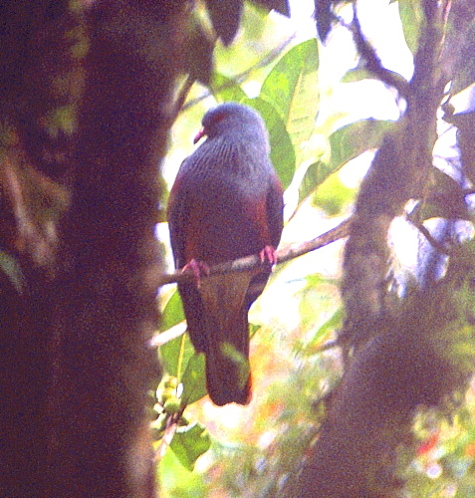

New Caledonia Pigeon.
EMERALD DOVE Chalcophapsindica chrysochlora
Two seen walking around the campsite on the 18th and one seen walking along the gravel road on the 19th.
Although appeared very similar to ones I have seen in Australia and Asia the dark breast was very well defined.

Emerald Dove
RAINBOW LORIKEET Trichoglossus haematodes deplanchei
Up to ten recorded on three dates in the Nat.Park.
NEW CALEDONIAN PARAKEET Cyanoramphus saisseti
A single bird seen near Yves house in the Nat.Park on the 16th and two seen in the Nat.Park on the 20th. This species has recently been split from the very similar Red-fronted Parakeet in New Zealand.
Medium size green parakeet with a yellowish tinge on the underparts,bluish wings and red crown and red stripe through eye and small red patches at the base of the tail. Long green tail. Noticeably smaller than Horned Parakeet. Generally a quiet bird and feeds quietly in the trees and could be overlooked quite easily.
HORNED PARAKEET Eunymphicus cornutus
All sightings from the Nat.Park with one on the 16th, five on the 18th and fourteen seen on the 19th with several seen well feeding in the trees. Considered by Collar as vulnerable due mainly to habitat destruction and trapping for the bird-trade.
Noticeably larger than the last species with a more extensive and darker blue area on the wings. Male has a distinctive yellow nape and red frontal area above bill and dark face. Female greener with far less red and no yellow nape. Both sexes have a very distinct long wispy crest and in flight a broader tail with bluish base.
BARN OWL Tyto alba lifuensis
A distinctive endemic subspecies. One found roosting on the edge on a small pine tree plantation just inside the Nat.Park by the entrance gate in the early morning of the 18th. It appeared noticeably darker on its head and back compared to our own Barn Owl.
WHITE-BELLIED SWIFTLET Collocalia esculenta uropygialis
Up to 15 seen daily at both the Nat.Park and Mount Koaghis.
Upper parts blackish with large whitish rump and underparts much paler grey. All birds kept very low gliding along the forest rides. A small party of Swiftlets were seen flying much higher in the sky higher up in the Nat.Park and may have been White-rumped Swiftlet Collocalia spodopygia leucopygia but when I discussed the identification with Yves Letocart he felt they were virtually impossible to identify in the field.
SACRED KINGFISHER Halcyon sanctus canacorum
Seen in small numbers daily. Maximum of 4 on a day.
WHITE-BREASTED WOODSWALLOW Artamus leucorhynchus melanoleucus
Up to five seen on a day in the Nat.Park with eight seen along the coast on the 20th.
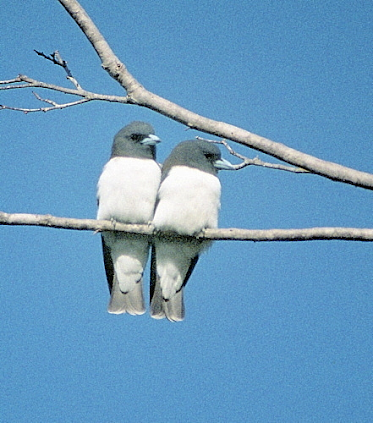
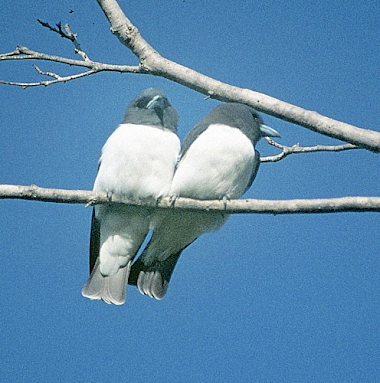
White-breasted Woodswallows.
STRIATED STARLING Aplonis striatus
Three seen at Mount Koaghis on the 17th with six in the Nat.Park on the 18th and two on the 19th and four near the coast on the 20th.
Very similar in appearance to Metallic Starling which I have seen in Queensland,Australia but the tail was noticeably shorter and no where near as pointed as that species. The birds we saw along the coast were in open land and therefore it is not restricted to forests.
COMMON MYNA Acridotheres tristis
Introduced, and seen on three dates around habitation.
NEW CALEDONIAN CROW Corvus moneduloides
Three seen on the 18th and two on the 19th in the forest at the Nat.Park.
A small Jackdaw size crow, all black in colouration with a large black eye and thickset stubby bill. It was a curious bird coming to pishing and usually carrying small sticks in its bill.
New Caledonian Crow carrying a stick.
CALEDONIAN MOUNTAIN GREYBIRD Coracina analis
Only seen in the forests at Riviere Bleue Nat.Park with four on the 18th, two on the 19th and two on the 20th.
We found this species difficult to come to grips with. It appeared fairly large for a Cuckoo-Shrike and the ones we saw kept to the mid-storey and were usually partly hidden by leaves. Yves picked a number out calling but none of these were seen by us. The call was a loud whistle and a short trill all sounded rather jumbled up to my ears.
Its general plumage is dark grey with a dark eye quite a large rounded head and longish broad tail but by far its most conspicuous feature was its rufous under-tail coverts which I found to be the best identification criteria. In general I found it to be a rather non-descript species, fairly elusive and not showing at all well.
MELANESIAN GREYBIRD Coracina caledonica
One seen at the entrance gate to the Riviere Bleue Nat.Park on the 16th, three seen at the start of the summit track at Mount Koaghis on the 17th and two seen in the forest in the Nat.Park on the 20th.
A larger bird than the preceding species they sit out much more in the open again at mid-storey level
and good views including photographs obtained. Plumage much blacker with blackish under tail coverts and an obvious white eye.
LONG-TAILED TRILLER Lalage leucopygia
Three seen in the 16th in the Nat.Park with one on the 17th at Mount Koaghis. Three seen on the 18th and one on the 20th again in the Nat.Park.
A black and white triller not unlike the Australian White-winged Triller but with a slightly longer looking tail. The ones I saw were usually on the edges of forest clearings.
NEW CALEDONIAN WHISTLER Pachycephala caledonica
Fairly common seen on all five days with a daily maximum of 15 on the 20th in the Nat.Park.
Similar in size to Golden Whistler. The male has a uniform grey head and the underparts more orangie-yellow and a narrow black breast band. Females browner-olive upper parts with a conspicuous white throat and dirty white underparts. It was interesting that while the males kept to the low to mid-storeys in the trees the females were often seen feeding on the ground. I found the best identification criteria to be the uniform grey head and the tones of the underparts of the males.

New Caledonian Whistler.
RUFOUS WHISTLER Pachycephala rufiventris xanthetraea
An endemic subspecies. Odd birds recorded on all five dates.
Its general appearance and behaviour was very similar to birds seen in Australia.
FANTAIL GERYGONE Gerygone flavolateralis
Common with up to fifteen seen daily.
An obvious Gerygone usually seen well flitting around in the forest. Small size similar to a phylloscopus warbler, with pale brown upper parts, whitish underparts with yellowish flanks and white tail spots. No real confusion specie on New Caledonia.
SPOTTED FANTAIL Rhipidura spilodera verreauxi
Common, recorded daily in the forest areas with a daily maximum of 12 at Riviere Bleue Nat.Park on the 20th.
A typical fantail in size and jizz with rufous-brown upperparts white supercilium and throat,breast with black spots and buff tips to the tail feathers. In the early morning,it would hop around on the ground flicking its wings turning fallen leaves with both of its wings looking for insects.
GREY FANTAIL Rhipidura fuliginosa bulgeri
Endemic subspecies. Seen daily but not as common as the preceding species and not so much of a true forest fantail as the preceding species. Daily maximum of five at Riviere Bleue and would be seen around campsite and picnic sites in more open areas.
Appeared virtually the same as its Australian counterpart.
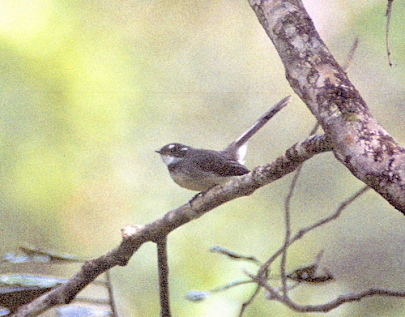
Grey Fantail.
NEW CALEDONIAN MYIAGRA FLYCATCHER Myiagra caledonica
Four seen on the 18th and one seen on the 19th at Riviere Bleue Nat. Park.
A stunning specie,especially the female. Yves called this specie the Wide Billed Flycatcher which seemed a far more appropriate name for it. The male was like a male Satin Flycatcher but with a far broader based bill with thick hairy bristles. The female much like Broad-Billed Flycatcher which I saw near Darwin but with even a broader based bill than that specie and a wide white eye-ring with a brighter orange throat and breast. They made a short sharp call and could be easily picked out on call once known.
New Caledonian Myiagra Flycatcher.
SOUTHERN SHRIKEBILL Clytorhynchus pachycephaloides
Just two singles seen and both at Riviere Bleue Nat.Park. The first on the 16th and the second which I watched feeding for some 15 minutes with some excellent views on the 20th.
Although classified as a Flycatcher, I would seriously question this as its jizz,structure and feeding behaviour was totally unlike any flycatcher I have seen. A medium size bird larger and heavier than most Flycatchers. Plumage non-descript brownish tips to the tail feathers and under tail coverts. Quite a longish tail and a large wedge shape pale bluish bill. It generally keeps to the mid to upper storeys where it moves around rather heavily. It feeds by poking its bill into crevices in the bark of the tree and I once watched it tear of a small piece of the bark with its amazing bill no doubt looking for insects under the bark. When it flew from tree to tree its flight was quite heavy.
YELLOW-BELLIED ROBIN Eopsatria flaviventis
Common with up to ten seen daily.
Similar in behaviour and looks to the Eastern Yellow Robin of Australia but probably slightly smaller.
Brown upper parts with grey face,throat and breast with belly and under tail coverts lemon yellow. A confiding bird often seen around the picnic sites and our camp site where it would sit out in a small bush and suddenly fly to the ground where it would hop about feeding, although it would also be seen in the dark forest.

Yellow-bellied Robin.
NEW CALEDONIAN WHITE-EYE Zosterops xanthomera
Common often in flocks seen daily with up to 40 on a day.
A typical looking white-eye being olive-green above very large white eye-ring, breast and flanks greenish-yellow vent whitish.
New Caledonian White-eye.
NEW CALEDONIAN MYZOMELA Myzomela dibapha caledonica
New Caledonica endemic subspecies of Australian Scarlet Myzomela or Honeyeater. Fairly common up to five seen daily.
Appeared identical to those I have seen in Australia.
SILVER-EARED HONEYEATER Lichmera incana
Seen on all four dates in secondary habitat at Riviere Bleue Nat.Park but never more than four seen on a day and not seen at Mount Koaghis.
Brownish-olive above with a brighter greenish panel on the wings. Grey underparts becoming whiter on the belly. Distinct grey ear coverts and the bill was decur
BARRED HONEYEATER Guadalcanasria undulata
Two seen at Riviere Bleue near the entrance gate on the 16th and up to 8 seen in the vicinity of the hotel at Mount Koaghis on the 19th.
I am surprised that I didn`t see more of this species and it is probably commoner than we saw it. For a Honeyeater it was quite impressive. Larger than the preceding species with quite a long decurved bill.
Upper parts greyish-brown with the underparts whiter with many narrow bars on the throat, sides of the breast and flanks.

Poor record shot of a Barred Honeyeater.
CROW HONEYEATER Gymnomyza aubryana
A single bird was taped into view by Yves along the forest road at Riviere Bleue Nat.Park on the 18th. The bird remained in the lower overhanging branches for some 10 minutes and gave excellent views. It immediately responded to the tape, coming in within seconds of the tape being played.
Size not as large as I was expecting, Jackdaw size but thinner with a longer tail. Long decurved bill was black above and yellow below. Yellow feet. All dull black plumage with bright red bare skin around the eye extending to the bill and red wattles on the side of the neck. A very odd looking bird.
Very dark picture of a Crow Honeyeater.
NEW CALEDONIAN FRIARBIRD Philemon diemenensis
Fairly common but shy seen daily with up to 12 on a day.
Medium size friarbird, Upperparts brownish with broad pale blue edgings to the wings. Greyish head streaked slightly darker with a pale and dark malar stripes. Underparts greyish-brown with long whitish pointed breast feathers,giving a streaked effect. Although I tried on a number of occasions to approach the bird to photograph it, it never allowed me to get to close and appeared quite shy although I saw it chasing other birds on several times. I was quite impressed with this friarbird.
HOUSE SPARROW Passer domesticus
Introduced , and seen around the Airport.
RED-THROATED PARROT-FINCH Erythrura psittacea
A stunning bird and one of the highlights. Singles seen on the 16th and 19th at Riviere Bleue and on the 17th at Mount Koaghis, with four on the 20th at Riviere Bleue. Good views obtained of most of these birds and some acceptable photographs obtained.
Small long tailed parrotfinch with a blackish conical shape bill. Body bright green with a red face,throat and the red long pointed tail. One was watched feeding on small fruit growing out from the trunk of a tree.
Red-throated Parrot Finch.
Sunset over New Caledonia.
REFERENCES
Cleere & Nurney A Guide to Nightjars and Related Nightbirds
Collar et al Birds to Watch 2 The World List of Threatened Birds
Clement et al Finches & Sparrows an Identification Guide
Juniper & Parr A Guide to the Parrots of the World
Thomas, Richard New Caledonia - A Trip Report 1992.
Many of the above descriptions were taken from Richard Thomas trip report and
I also used this trip report extensively in New Caledonia and found the
identification notes to be extremely useful as I had no field-guide to the area.










